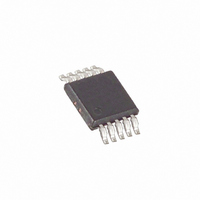MAX1812EUB+ Maxim Integrated Products, MAX1812EUB+ Datasheet - Page 8

MAX1812EUB+
Manufacturer Part Number
MAX1812EUB+
Description
IC SW USB DUAL W/FB 10-UMAX
Manufacturer
Maxim Integrated Products
Datasheet
1.MAX1812EUB.pdf
(10 pages)
Specifications of MAX1812EUB+
Applications
USB, Peripherals
Current - Supply
45µA
Voltage - Supply
4 V ~ 5.5 V
Operating Temperature
-40°C ~ 85°C
Mounting Type
Surface Mount
Package / Case
10-MSOP, Micro10™, 10-uMAX, 10-uSOP
Maximum Operating Temperature
+ 85 C
Minimum Operating Temperature
- 40 C
Mounting Style
SMD/SMT
Lead Free Status / RoHS Status
Lead free / RoHS Compliant
Dual USB Switch with Fault Blanking
The MAX1812 limits switch current in three ways
(Table 1). When ON_ is high, the switch is off, and the
residual output current is dominated by leakage. When
ON_ is low, the switch can supply a continuous output
current of at least 500mA. When the output current
exceeds the 0.9A (typ) threshold, the MAX1812 will limit
the current, depending upon the output voltage. If
V
the switch drive so that the peak current does not
exceed 1.2A (max). If V
the MAX1812 pulses the switch drive to decrease the
current to 0.35A (RMS). Note that a thermal overload
may result from either of these high-current condi-
tions.
The switches in the MAX1812 may enter current limit in
normal operation when powering up or when driving
heavy capacitive loads. To differentiate these condi-
tions from short circuits or sustained overloads that
may damage the device, the MAX1812 has an inde-
pendent fault-blanking circuit in each switch. When a
load transient causes the device to enter current limit,
an internal counter monitors the duration of the fault. If
the load fault persists beyond the 20ms fault-blanking
timeout, then the switch turns off and the FAULT_ signal
asserts low. Only current-limit and short-circuit faults
are blanked. Thermal overload faults and input voltage
8
Table 1. MAX1812 Current Limiting and Fault Behavior
OUT_
If thermal fault condition
If an overload current
_______________________________________________________________________________________
If a short circuit
> 1V (current-limit mode), the MAX1812 serves
CONDITION
(V
(V
is present
is present
is present
OUT
OUT
< 1V)
> 1V)
Behavior During Current Limit
OUT_
If a short circuit is present at startup, current will ramp up to ISHORT in 2ms–3ms, and the switch
will shut off. The blanking timer turns on, but FAULT_ stays high.
If a short circuit occurs during operation, current output will be pulsed at 0.35A (RMS).
If ISHORT is exceeded between 15ms–20ms, then the short circuit is still present and FAULT_ goes
low at 20ms. When the short circuit is removed, the next ramped current pulse will soft-start the
output. The FAULT_ flag releases at the end of the next cycle.
Current will regulate at ILIM (0.9A typ). The blanking timer turns on, but FAULT_ stays high.
Continuous current at ILIM persists until the overload is removed or a thermal fault occurs.
If overcurrent is still present at 20ms, then FAULT_ goes low.
When the overcurrent condition is removed, the FAULT_ flag releases at the end of the next cycle.
FAULT_ immediately goes low (the blanking timer does not apply to thermal faults), and the switch
turns off.
When thermal condition is removed, switch control returns to the current-limit loop. FAULT_ goes
high at the end of the timer period if no further thermal or current-limit faults exist.
< 1V (short-circuit mode),
and Fault Blanking
drops below the UVLO threshold immediately cause
the switch to turn off and the FAULT_ to assert low.
Fault blanking allows the MAX1812 to handle USB
loads that may not be fully compliant with the USB
specifications. USB loads with additional bypass
capacitance and/or large startup currents can be suc-
cessfully powered even while protecting the upstream
power source. If the switch is able to bring up the load
within the 20ms blanking period, no fault is reported.
The power for all control and charge-pump circuitry
comes from IN, INA, and INB. All three IN_ pins must
be connected together externally.
To limit the input voltage drop during momentary output
short-circuit conditions, connect a capacitor from IN_ to
ground. A 0.1µF ceramic capacitor is required for local
decoupling; however, higher capacitor values will fur-
ther reduce the voltage drop at the input (Figure 2).
When driving inductive loads, a larger capacitance will
prevent voltage spikes from exceeding the device’s
absolute maximum ratings.
An output capacitor helps prevent inductive parasitics
from pulling OUT_ negative during turn-off. At startups,
MAX1812 BEHAVIOR
Applications Information
Input Power Source
Output Capacitor
Input Capacitor










